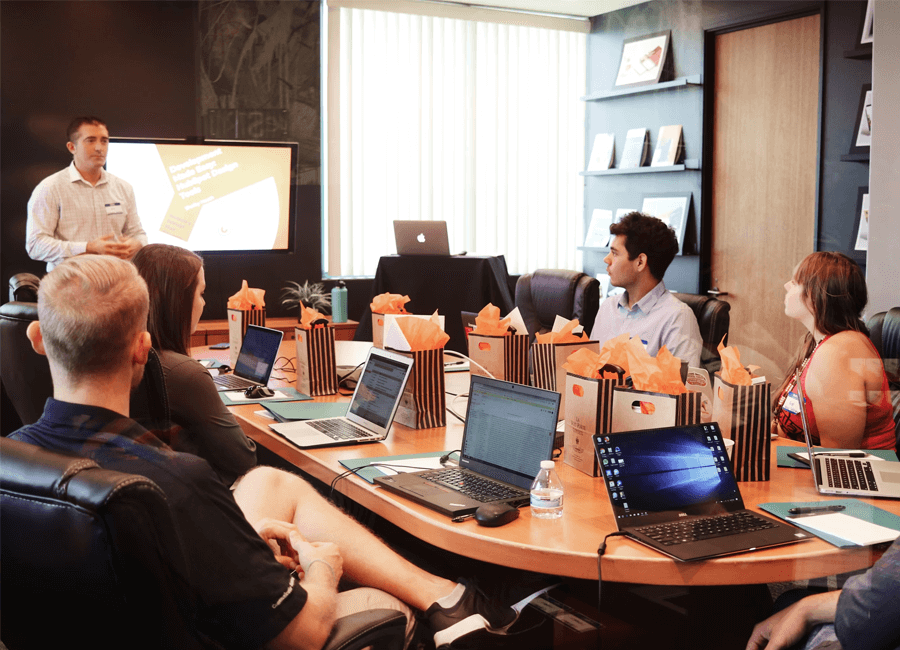Data reporting has remained a hot topic debated by insights teams in all industries in the world. With innovation transforming traditional reporting and creating new modern methods, we can see the impact of different approaches tailor-made for different stakeholders.
However, these methods are still being refined and with more methods comes a choice paralysis when it comes to deciding which one to use at which occasion for how many stakeholders, and that is the price of innovation. So how do insight experts tackle this issue and deliver impactful reporting to their stakeholders? This is the topic up for discussion in our latest roundtable, hosted by Maria Twigge, Research Director at FlexMR and attended by six insight experts from a range of industries:
- Ross Hilliard - Head of Research & Insight at Collinson Group
- Emma Gough – Research Manager at Biffa
- Viv Harrison – Research and Insights Manager at the Caravan and Motorhome Club
- Shehnaz Hansraj – Head of Research and Insights at Viking Cruises
- Paul Hudson – CEO of FlexMR
- Katharine Johnson– Client Success Manager at FlexMR
A big thanks to all our attendees who contributed to a lively, educational and inspiring discussion that dove deep into the challenges of data reporting, the nuances of each choice in front of them and the importance of context for a more accurate report. This was a great addition to the industry-wide discussion with numerous insightful ideas for future use.
| Tweet This | |
| What data reporting strategies have real insight experts found impactful in their organisation and have engaged stakeholders? |
What is Impactful Reporting?
The first question posed to kick off the discussion was: what reporting have you seen that has been impactful and memorable?
Maria started off the discussion by mentioning that she believes the most impactful reports are visual and emotive, noting that the best debriefs Maria has come across had visual illustrations of the key points across well. There is a point to this, where insight experts have noticed that strong visuals can have a strong impact on stakeholders. With visual reporting becoming more common in the insights industry, there was a lot of discussion about the types of visual reporting that can have a great impact.
A carefully curated video of a few clips of actual customers has been noticed by a few of our attendees to be impactful, but one mentioned that they are typically hand-selected, and so might not cover all insights from the data. It was mentioned that there is a danger of overthinking things when it comes to curating video libraries and reports that strangles the potential impact of the data and insights. It’s better to let stakeholders see how customers express themselves, how they write, and how they communicate – not editing and curating the videos can reveal a lot of insights that stakeholders need but aren’t identified at the start.
Other types of videos are useful too - animated or metaphor videos that tell a story can lead to behavioural change. Storytelling is crucial, visual or otherwise, to capture stakeholders’ attention and get them to open the email, read the debrief and absorb the data and insights. Stories can be found in any format though, so if a video isn’t available, quotes are just as impactful and can still count as a visual if they’re presented on their own.
While videos are great, there are other visuals that insight experts can and should implement when possible. A couple of our attendees mentioned that they vary data visualisation and storytelling as much as possible, but that one challenge to this is that there is no shortcuts at the moment in this area, and they, along with every other insight expert in the field, have no time to be messing about with programming and fancy visuals that ultimately aren’t going to get listened too. Because data reporting in the modern day has to be immediate, otherwise stakeholders are busy and won’t pay attention for long enough to get to the point.
It is well-known that one of the most damaging things in this industry is a stakeholder’s limited view of research, its potential, and its challenges - this is doubly so when it comes to commissioning research and acting on the insights generated. When commissioning the research, our attendees noted that they have experience with stakeholders who come to them to see if they can get specific results, when actually the data shows something completely different. Stakeholders, while not fully understanding the data in front of them, are also known to willfully misinterpret and manipulate the data to get it to show whatever they need it to show, context be damned. This context is crucial to understanding the truest interpretation of the data and acting in the right way.
With every stakeholder needing a different way of engaging with data, insight experts should be using a variety of techniques to capture and keep their attention. Those stakeholders who ask a question and understand the important context behind the data are more likely to drive action.
When stakeholders aren’t invested at all, one method that most of our attendees agreed were their most powerful reporting tool was a killer statistic, that shocking insight that no stakeholder would anticipate but would change the way they view the business, product or consumer base entirely. Surprise makes a bigger impact than simply confirming hypotheses.
However, reaching stakeholders is another issue entirely. Now the pandemic has thoroughly changed the way we work, stakeholders are now never in at the same time with hybrid and shift working. Insight experts need to change their tact of how they’re communicating and distributing research - a few of our attendees shared how they communicate insights on a regular basis, with virtual online insight distribution channels and “Research Wednesdays”, an open-to-everyone meeting making an appearance. But while we want to share insights as much as possible and create great reports as often as possible, if it becomes too frequent or repetitive then it’s been noted by all attendees that stakeholders switch off and attendance in debriefs/research meetings drops.
It was discussed that most reporting now has to be so much faster, with continuous tracking helping insight experts to get real-time insights, but otherwise, we need to do things faster and more flexible now. With tactics such as pre-research forms to get a sense of stakeholder expectations and rapid response services being developed for agile, tactical decisions.
One attendee mentioned that they thought a menu of research experiences with prices and expectations would be very useful to level with stakeholders about what data and insights they’d get with each level of research experience. Then, insight teams can focus on generating impactful data and reports that engage stakeholders.
The Importance and Challenges of Data
The next question that sparked some creative debates was: how do we ensure we are reporting daily in the best way? With daily reports being a more ‘run of the mill’ type of report, stakeholders are used to receiving data-filled written reports that aren’t the most efficient use of their time. So we asked our attendees to explain what measures they’ve put in place to revolutionise the ‘run of the mill’ reporting and make it more engaging for stakeholders.
One attendee mentioned straight away that they partner with a data insights team who generate dashboards that are actually live feeds, so all of the data that is currently being generated and the insights revealed all automatically get stored in this one live platform that their stakeholders have access too – it’s all fully automated to keep everything fully updated, and then this platform is integrated into their intranet system for the best accessibility.
This ‘data warehouse’ type approach has long been held aloft as the pinnacle of data democratisation, however, through this, there have been some significant challenges revealed. The more the better isn’t always true, and stakeholders don’t actually access it as much as they need to, or if they do then all they see is a sea of data and have no idea where to start looking for the answer to their questions.
These types of data stores also have a hard time retaining the relevant context behind the data - the background situation and experiences that informed the data, so that means passing the data between sources without the relevant context means the other parties won’t understand the importance of the data. Context is everything, one attendee noted that is especially true for consumer behaviour, using the example that today’s 53-year-old doesn’t behave like a 53-year-old ten years ago, so when looking at the data, it’s important to understand exactly when it was generated and in what situation it was generated in.
However, the data stores accessible by everyone in the organisation can help break down departmental silos that block the flow of information around the business in multiple ways: the first mentioned by our attendees was that we should have a facility where stakeholders can leave comments on data reports, specific insights that are also universally seen and added to by other stakeholders from across the organisation. This feature would open up the discussion and create a forum-like atmosphere in the data store, with space for relevant context and added information about how it’s been used across the organisation, which can then inspire others.
A feature to really help stop these stores from becoming data dumps (a common concern mentioned multiple times by our insight experts) is a search function, with the facility to search for different queries and products that would bring up answers or highlight gaps in the store.
While the universally accessible data store will help break down silos, there are still challenges that occur, for example, within an organisation there are so many different teams now with a different views of the customer, so keeping the vision consistent and joining it all together to form one master view is one very significant challenge. Our attendees agreed that insight experts are in a prime position to see all those different views and influence each team where there is a silo to make sure each team is working towards a shared goal. Stakeholder teams need to understand each other’s viewpoints, and the risk here creates blocks to decisions and differing strategies.
So with all of these pros and cons to using data stores, the questions then become: if democratise access, does it actually get more widely used? Or is the risk that context is lost and the relevance is gone too much for insight experts and stakeholders to handle? How do insight experts democratise data and still remain in control?
Different Approaches to Engagement & Reporting
When it comes to data reporting, we need agility and accessibility as no two stakeholders want the same thing and the phrase ’let’s check on insight platform to see’ needs to be in the daily language of decision-makers everywhere.
Some of the engagement considerations our attendees revealed when it comes to making this a reality were: Does everyone want access to data and insights? Does daily reporting contribute to information overload? Can stakeholders cut through the noise of a data store or report to grab the data they actually need? Do they know what data they need?
Lots of insight teams don’t have stakeholders on their research platform, or if they do it’s only with limited access to view the data generated or watch respondents interact with live research tasks. There are a couple of ways of getting stakeholders engaged with research, from a little video on the homepage to pique stakeholder interest to encouraging the very first log-in. From this, we can understand what sort of data different stakeholders want and the level of access they should have to really revolutionise their decision-making processes.
Our attendees noted that one study satisfies a range of different teams around the business, but even so there’s no guarantee of those teams taking an interest in the value of research. How do insight teams drive value? Our attendees agreed that it always helps if you understand the stakeholders’ agendas – what are their priorities? then draw insights based on that. They’re time-constrained, so punchy reports are needed. They’re also more focussed on their own departments, so we need to break down silos and make sure they know how their department contributes to the success of the business as a whole.
In terms of the reporting methods themselves, emails get easily buried, and when reporting data, we want that data to be accessed and used again and again, so how do you engage audiences without email and attachments?
One concern that was mentioned by many attendees was that making something look great takes time and tools, more time and tools than most insight experts have access to. As human beings, we are visual creatures, but the visuals we come across on a daily basis don’t always have to be fancy. For those analytical ones, they can be suspicious of the pretty reports, but those that need the pretty reports won’t give spreadsheets the time of day because they don’t fully understand them.
When looking to engage as many stakeholders as possible we must look to ourselves for inspiration, so our attendees looked to what engaged them on a daily basis. One of the more creative thoughts was to mirror social media platforms with specific groups for business teams. Using an Instagram or Pinterest-like dashboard insight teams can post interesting research bites and store insights, message through to specific stakeholders or teams, see who’s viewed what post and organise data and recorded research to be easily searched and interacted with by all who want to - this would engage those stakeholders with even the shortest of attention spans.
Longer-form research reports can still be visually appealing and engaging to stakeholders. Infographics are a go-to for most insight teams and a couple of our attendees mentioned typically getting more feedback on infographic reports than any other report. Making research bite-sized and visual like this helps engage more stakeholders, and this can work for videos too. As mentioned earlier, videos are great visual reporting methods, and making quick 30-second research reports will help make research more accessible for time-strapped stakeholders.
Quiz-type reports could be a great way to help engage stakeholders one of our attendees mentioned. These could communicate insights in a more interactive way, and help them feel more connected to research respondents as they go through a few questions and multiple choice answers, then they can compare and discuss among themselves when they’re done.
| Tweet This | |
| Ultimately, the best approach to data reporting will depend on the answer to one question - who are you trying to engage? |
The Future of Data Reporting
We can discuss different approaches, their effectiveness and incremental improvements for days. But ultimately, it all comes down to one simple question.
Who are you trying to engage?
Personalised reporting can be seen as a waste of time, but is it really if it helps engage more stakeholders in research than otherwise? Engaging stakeholders on a higher level increases the level of data literacy in the organisation. Some stakeholders will always simply trust and rely on insight teams and need interpretation, but other stakeholders understand and want to look at the data themselves. Through engagement in the research and data reporting process, we can build trust and allows those non-traditional researchers to get involved in the process.


















